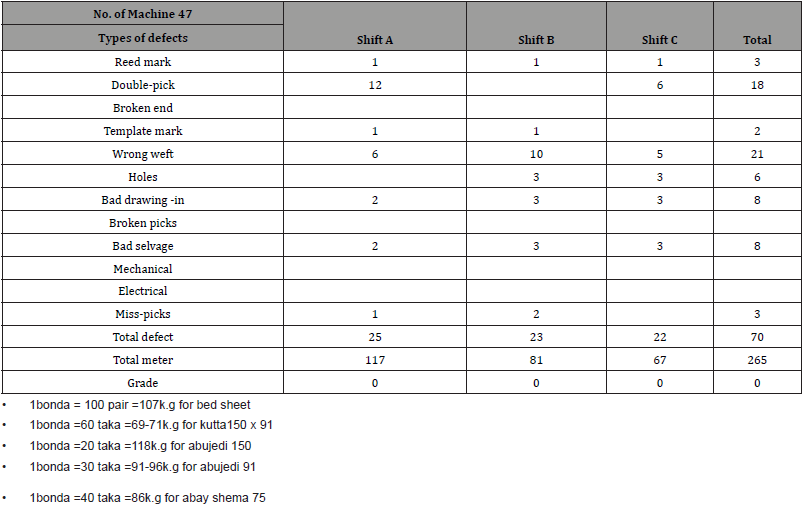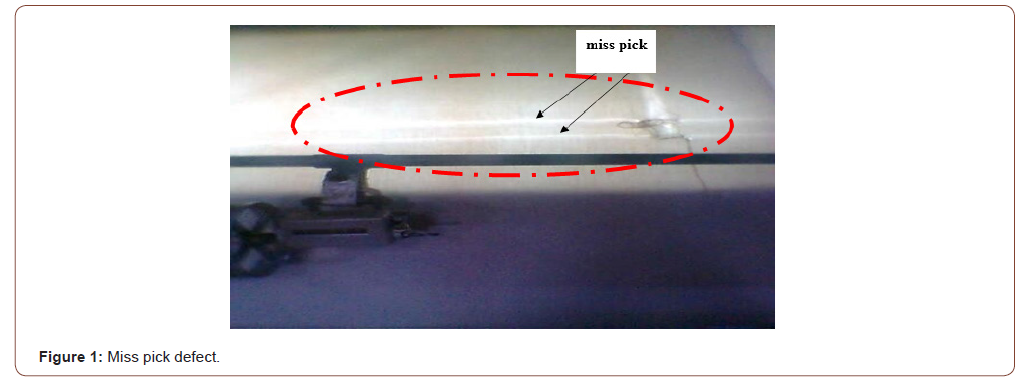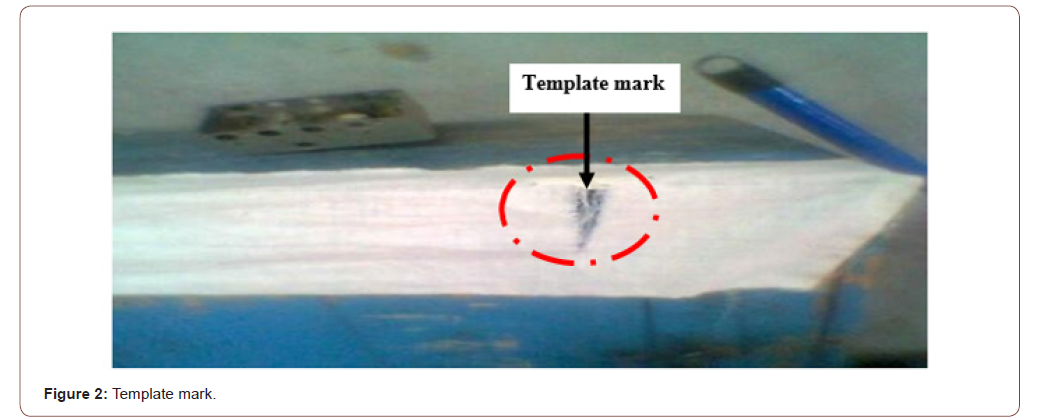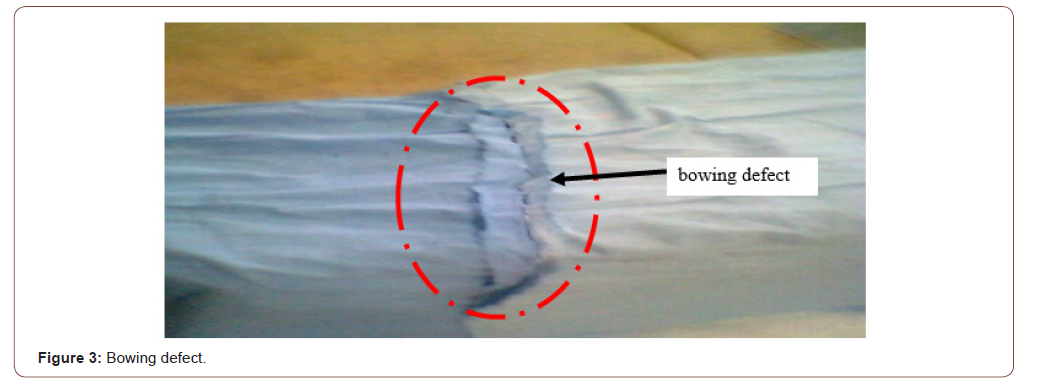 Research Article
Research Article
Causes of Woven Fabric Defects and Cost Analysis: Case Study at Bahir Dar Textile Share Company (BDTSC)
Biruk Gedif*
Ethiopian Institute of Textile and Fashion Technology (EiTEX), Bahir Dar University, Ethiopia
Biruk Gedif, Ethiopian Institute of Textile and Fashion Technology (EiTEX), Bahir Dar University, Bahir Dar, Ethiopia.
Received Date: December 03, 2020; Published Date: January 08, 2021
Abstract
During the manufacturing of woven fabric, due to different reasons, there are a lot of wastes are removed. One of the aims of all manufacturing companies is minimizing waste during manufacturing or processing. So that waste reduction is the primary focus for textile industries. This paper studied the cause of the fabric defect during weaving processes and give a recommendation solution. Bahir Dar Textile Share Company (BDTSC) has been totally from 16448.35meter fabric is 38652.825birr/week and 11683.325birr/week is gotten and lost respectively. BDTSC due to different defects/problems lost (11683.325 x 4 x 12) = 560799.6 birr/year.
Keywords: Textile; Weaving process; Woven fabric; Fabric defect
Introduction
One of the oldest civilizations of Africa, Ethiopia is today at the advent of industrialization in various business sectors. Agriculture is a primary source of income is now transforming into more dynamic and new sectors [1]. The textile industry is one of the most important sectors in Ethiopia. Because the Ethiopian government has spearheaded the sector as one of the key priority sectors for which has contributed to the multiple aspects towards the economy of Ethiopia such as, investment, occupation and export. This is supported by the creation of various industry policies and incentives to attract foreign direct investors [1-4]. Therefore, textile and apparel are one of the sectors that has received a lot of attention from the government and the objective is to become sourcing destinations of the world [1]. The textile industry mainly three basic sections those are spinning process, weaving and finishing. Under weaving processes, there is a fabric formation process which is called woven fabric.
During the manufacturing of woven fabric, due to different reasons, there are a lot of wastes are removed. One of the aims of all manufacturing companies is minimizing waste during manufacturing or processing. So that waste Reduction is the primary focus with all clothing & others to help find a new owner for them. The focus is to reduce, reuse, upcycle, recycle. From the environmental point of view, one way to benefit both your community and the environment is to donate used textiles to recycling organizations. Most recovered household textiles end up at recycling organizations, who sell or donate the majority of these products. The remainder goes to either a textile recovery facility or a landfill [5].
Textile recovery facilities separate overly worn or stained clothing into a variety of categories. Based on data from the Council for Textile Recycling, it was estimated that 1.3 million tons of textiles in clothing were recovered for recycling in 2009. Some recovered textiles become wiping and polishing cloths. Cotton can be made into rags or form a component for a new high- quality paper. Knitted or woven woolens and similar materials are “pulled” into a fibrous state for reuse by the textile industry in low-grade applications, such as car insulation or seat stuffing [5,6]. Other types of fabric can be reprocessed into fibers for upholstery, insulation, and even building materials [7,8].
This research focuses on Bahir Dar Textile Share Company (BDTSC) which is one of the oldest textile companies in Ethiopia. BDTSC was established in 1954 E.C in the Amhara region near Abay River (Nile River) during the period of Emperor Halie Selassie. It is far 570km from Addis Ababa in the North West direction. The more initial capital had been covered by Italy government due to blood compensation in the case of the Second World War. The small initial capital had covered by axion share by the following organization:
• Agricultural and industrial bank of development
• Ethiopia cement corporation
• Commercial bank of Ethiopia
• Ethiopian small industry axion
• Debre Berhanu wool factory
Case study: Study the cause Woven Fabric Waste in Weaving Processes
A fabric defect is any abnormality in the fabric that hinders its acceptability by the customer. Most defects in cloth occur while it is woven on the loom. Some of these fabric defects are visible, while others are not. Some common fabric defect is broken pick, broken end, ununiform dyeing &printing, miss pick, rusting, bowing, etc., which are occurred due to different cause such as carelessness of operator/worker, machine arrangement, quality of input material, quality of auxiliary material, etc. Due to this defect, the company lost some amount of income from a little length of fabric.
General objective
The main objective of this research work is to study fabric waste in weaving processes.
Specific objective
• To trace the source of the defect, so that appropriate measures can be taken to make use of the faulty fabric.
• To minimize the future reoccurrence of the defect.
• To determine the quality and hence the price of fabric
Methodology
This research was constituted methods of data collection, data presentation, data analysis conclusion and recommendation.
Methods of data collection: The required data and the necessary parameters that get information are in different ways. Such as by interviewed for different peoples (like operator, quality controller person, etc.), by literature observation and by reading different materials to study fabric defect or a waste of fabric, to improve the quality of the fabric and increase productivity at the end.
Data presentation
Mathematical/statistical calculation is carried out to analyze the data: Calculate the company will be get and how much will be lost from the given data (Tables 1-3).
Table 1:Weaving and finishing defect per week.

Table 2:Product, defect/waste, UOM, and price without vat.

Table 3:Gray fabric inspection test.

For bedsheet 160
• From 3459.62 meter of sheet 160 we get 339.62m of fabric is waste. 1bonda=100pair
• =107kg, for 1pair=250cm x 2=5m =1. 07kg, So for 5m length of bed sheet 160 =1. 07kg, then for 3459.62m is740. 36k.g, 339m is 72.55k.g and for o.62m is o.133 kg. The net weight or for 3120m of bedsheet160 is 667.677kg.
• For a 5-meter length with 160cm width or 1.07k.g of bed sheet proposed price without vat is 140.4 birr. Then for 3459.62m or 740. 36k.g of bed sheet is 97146.13birr. and 339.62m or 72.683kg of bed sheet is 9536.53 birr.
• But the company paid the cut pieces: sheet 160 of 1k.g of cut pieces in 1m length is 58 birrs so for 72.55kg or 339m is 4207.9 birr. And from 0.5 to 99cm length of cut pieces of 1kg is paid 45birr then for 0.133kg or 62 cm of bed sheet 160 is 5.985birr.
• The company will get from 339.62m (339meter+0.62meter) or72. 683k.g of the waste fabric is 4213. 885birr. The company lost from 339.62 meter is 9536.53 - 4213.885birr = 5323.115birr. The net product (get) from 3459.62 meters of bed sheet 160 is 97146.13- 5323.115 = 91823.015 birr per week.
The company also gets and lost from 5706.28 meters of bed sheet 137 is:
From5706.28m of bed sheet 137cm 443.88m is as waste, then 230cm x 2 (since it is pair) = 4.60m =110.94birr and for 5706.28m is 137620.59 birr, for 443.88m of bed sheet137 is 10705.23birr. But for 1m cut pieces of bed sheet, 137 paid 11birr. Then for 443.88m of cut pieces of sheet137 is paid 4882.68 birrs.
• The company lost from 5706.28m of bed sheet 137 is 137620.59 - 4882.68=5822.55birr.
• The company gets net from 5706.28m of bed sheet 137 is 131798.04birr.
From 7282.45 meter of kutta 150 51.85m is as a waste x1taka=20m =447.39birr, 60 taka = 1200m
For 20m=447.39birr=1taka, then 7282.45m is 162904.77birr and for 51.85m is 1159.86birr. But for 1m cut pieces of kutta150 is paid 12birr so for51.85m is 622.2birr.
• The company lost from 7282.45m of kutta150 is 622.2birr.
• The company gets from 7282.45m ofkutta150 is 162367.11birr.
In short, as see the above from analysis the company will get from 3459.62m of bed sheet160 is 91827.015birr/week, but it lost from this meter of fabric is 5232.115birr/week. And from 5706.28m of bed sheet 137 the company will get 131798.04 birrs and lost 5822.55 birrs/week. In addition to this from 7282.45m of Kutta 150, the company will get 162904.77birr and lost537.66birr/ week.
Bahir Dar Textile Share Company has been totally from 16448.35meter is 38652.825birr/week and 11683.325birr/week is gotten and lost respectively. BDTSC due to different defects/ problems lost (11683.325 x 4 x 12) = 560799.6birr/year.
The defect/problems of fabric cause and ways of solution or recommendations are as follows bellow. If there is high defect during producing and dyeing of fabric there is low quality, high waste, low productivity and low income.
Cause Fabric Defect
Reed mark
A warp ways crack or disturbance of fabric structure which is not associated with missing Yarns and where the weft dominates. The cause of this defect is by a reed miss-draw or by damaged/ defective reed.
Miss-pick
Miss-picks are bars across the fabric with low weft density due to the absence of one or more weft threads. Cause of this defect is an improper function of take-up motion, improper assembly and adjustment of the warped brake and feeding mechanism, improper function of misspoke control, abnormal function of loom brake and weft fork motion, the incorrect sequence of weft insertion, carelessness of operator and in short miss-pick can occur due to picking action to actuate without weft insertion (Figure 1).

Double pick
Due to timing problems, push-button control quick and accurate start forward and reverse running. Brocken ends one or more warp yarn absent on the fabric due to the carelessness of the operator/ drawer.
Bad end and weft:
• Bad end: two or more warp thread cross each other due to the carelessness of the drawer/ operator.
• Bad weft.
• Thick places- thick places are bars across the fabric with greater weft density than on the rest of the fabric. Thick places caused by disarrangement of take-up motion, Improper loom stoppage and improper warp let-off motion.
• Thin places- a thin place is a defect of fabric. The weft density throughout the full length and at separate places of the fabric is lower than the adopted or required. But our interest was to produce a fabric with almost constant weft density throughout the length of fabric as much as possible. Due to spinning faults like yarn unevenness, neps, twist variation, etc. cause of fabric thick and thin.
Bad/wrong drawing-in: This defect is very difficult for the next process. Due to this problem bad end and bad Knott may occur. The cause of this is the carelessness of the drawer.
Bad selvage: There are so many types of selvage in different fabrics and different looms.
The causes of these defects are slackening/change in tension of selvage threads at irregular winding on weaver’s beam, the inadequate interweaving of selvages or thread thickness due to which the contraction Selvedge and ground is different, improper drawing of selvages threads in the harness and reed, too great or too small density of the ground relative to the interlacing, too slack or too tight tensioning of the weft threads and selvage device does not perform its proper function.
Oil and grease-oil, grease and waxes are (example from spin finishes, lubricants, sizing waxes and loom oils) which are not removed before dyeing can cause reserving and, as with sizing reduces, leads to dyeing ununiform (un levelness). Precipitated dye or undissolved dye particles cause dye stains. Inappropriate finishes lead to the formation of chalky marks when the fabric is scratched. Causes of these defects are; the carelessness of mechanic, operator, the improper arrangement of machine parts and do not use the scouring process to remove this type of defect.
Hole: If there is a hole present the fabric, causes of these problems are; the carelessness of the operator, quality of yarn and machine arrangement.
Temple mark: This defect occurred due to compactness or maintenance problem or dust (fluff) Problem (Figure 2).
Bowing: Usually caused by finishing woven filling yarns lie in an arc across fabric width, it is critical on solid color fabrics (Figure 3).


Torn selvage: Three or more adjacent selvage yarns, including the outermost, or catch, yarn is severed. The cause of this defect could be by; poor construction of the selvage or undue strains imposed during weaving or finishing.
Bowing: Usually caused by finishing woven filling yarns lie in an arc across fabric width, it is critical on solid color fabrics (Figure 3).
Ways of solution for the Fabric Defect
So far, we had discussed the type of fabric defect and the cause of the defect. Now let us see/give the ways of solution for the defect to increase the quality of the fabric, increase productivity, income and to enjoy the benefit.
Control the quality of warp and weft yarns
The degree of fabric defects especially for woven fabrics depends on the defects/faults of both the warp and weft yarns because the quality of fabric depends on the quality of yarn. When we say yarn quality properties like yarn hairiness, yarn evenness (yarn structure regularity) uniformity of yarn diameter, tension, etc. are properly control.
Citation: Biruk Gedif. Causes of Woven Fabric Defects and Cost Analysis: Case Study at Bahir Dar Textile Share Company (BDTSC). J Page 6 of 7 Textile Sci & Fashion Tech. 7(3): 2021. JTSFT.MS.ID.000664. DOI: 10.33552/JTSFT.2021.07.000664. Control (satisfactory) preparatory preparation of warp and weft yarn for weaving
The supply of weft yarn for weaving is a winding machine, so this winding machine is: Physical and mechanical properties of the yarn should not be impaired. The package should be built to ensure easy running- off during weaving at high speed, the package should be contained the maximum length of yarn, the yarn ends should be tied with strong knots of the correct structure easily passing at the subsequent process, the process should remove the objectionable fault, the yarn tension should be regular and ensure the constant winding condition
Warp yarn quality control
The tension of all wound ends must be uniform, all ends should be of the same length, the sized warp must be sufficiently strong, smooth and elastic by uniformly penetrate size solution, the sizing process should ensure the correct application of the required amount size on the warp yarn.
In short warp and weft yarn preparation is takes place in the preparatory department. Therefor some faults like a thin place, thick place, slubs, neps, must be eliminated at warp winding process so that we get a good quality of yarn for producing fabric without defect. If we did not remove those faults of yarn, the fabric appearance will be affected. In the warping process, the tension of warp yarn must be constant, and fluff and dirt will be cleaned from the surface of the yarn. Otherwise, if the tension is irregular or ununiform, the strength of yarn will be affected which results in more breakage of warp and weft yarn in the weaving process. The product that is fabric appearance will be affected by a greater number of knots of warp yarn.
In the sizing process, as we know the yarn must be impregnated with a size solution to take up the friction and make it smooth. If the sizing process is properly performed, the strength of the yarn will be improved, and breakages can be less in the weaving process which leads to fabric defect.
Properly arrange the machine /loom
Fabric defect can occur due to the incorrect arrangement of the machine part. For instance, if the take-up motion and the letoff motion get trouble in their arrangements, improper function of those two mechanisms could lead either high density or low density in picks /cm, then fabric does not have an equal number of picks/cm throughout its length.
Besides these; if the reversing mechanism is not proper it occurs miss pick or doubling of picks on the fabric. The gripper also inserts without weft yarn there is occur miss pick, and it inserts double with weft yarn in one shed it can occur doubling of the pick. Therefor arrange and check the machine and machine part properly work or not.
The quality of an auxiliary material is high
When we consider the auxiliary material of the machine-like oil, Furness, sizing ingredient and dyestuff, etc. are affect the quality of fabric which leads to fabric defect s when their quality is low. Therefore, the quality of auxiliary materials is as much as possible high.
Properly maintaining the equipment
Maintenance of the equipment or machines is according to the schedule is necessary. The equipment has its own program of a maintenance schedule. So, if it is not repaired on its required specific time, defect on fabrics can arise. When we say maintenance & repair it includes the following operations: properly cleaning & remove dust, properly oiling & lubricating, properly repair of wear out /damaged or broken parts of the equipment, mechanical & electrical system must be synchronizing.
Especial careful cleaning is essential for moving parts, gearing and thread guides, lubrication should not excessive so that oil does not flow on the surface of parts. If lubrication and cleaning take place according to the instruction manual of that specific machine, the chance to get defects on fabric will be less. If some parts of this machine are wearing out, damaged and broken it must repair either in minor, medium or overall according to the degree of damage of that particular part. Hence, other equipment’s or machine which are used for preparing yarn and fabric must be also maintained and repair depending on the instruction of the manual to get fabric without defect.
Aware or teach the operator (worker)
To produce fabric without defect, the skill of the operator and the assistant is very important.
Conclusion
Bahir Dar Textile Share Company (BDTSC) has been totally from 16448.35meter fabric is 38652.825birr/week and 11683.325birr/ week is gotten and lost respectively. BDTSC due to different defects/ problems lost (11683.325 x 4 x 12) = 560799.6 birr/year.
Acknowledgement
None.
Conflict of Interest
Author declare no conflict of interest.
References
- Khurana K (2018) An overview of textile and apparel business advances in Ethiopia. Research Journal of Textile and Apparel 22(3): 212-223.
- van der Pols D (2015) Business opportunity report Ethiopia textile & apparel industry Commissioned by Netherlands Embassy in Addis Abeba CBI and Nash international BV.
- Wagaye BT, Walle GA (2018) Overview of Ethiopian Textile Industry. Journal of Textiles and Polymers 6(2): 117-120.
- Whitfield L, Staritz C, Morris M (2020) Global Value Chains, Industrial Policy, and Sustainable Development–Ethiopia’s Apparel Export Sector. Development and Change 51(94): 1018-1043.
- Nosker TJ, Renfree RW (1999) Composite building materials from recyclable waste. Google Patents.
- Şule A (2012) Prediction of textile waste profile and recycling opportunities in Turk. Fibres & Textiles in Eastern Europe 5(94): 16-20.
- Mishra R, Behera B, Militky J (2014) Recycling of textile waste into green composites: performance characterization. Polymer Composites 35(10): 1960-1967.
- McGee D (2005) System and method for processing waste and recovering recyclable materials. Google Patents.
-
Biruk Gedif. Causes of Woven Fabric Defects and Cost Analysis: Case Study at Bahir Dar Textile Share Company (BDTSC). J Textile Sci & Fashion Tech. 7(3): 2021. JTSFT.MS.ID.000664.
-
Textile, Weaving process, Woven fabric, Fabric defect
-

This work is licensed under a Creative Commons Attribution-NonCommercial 4.0 International License.






